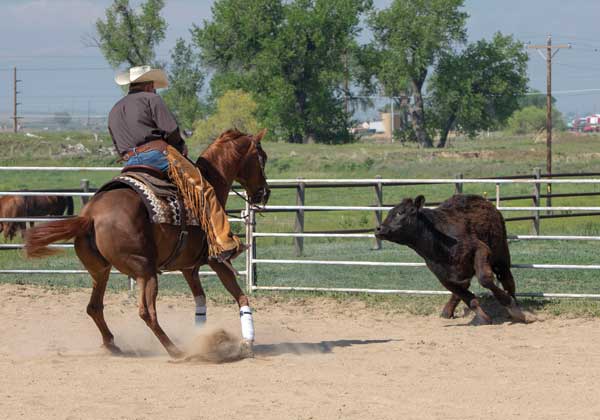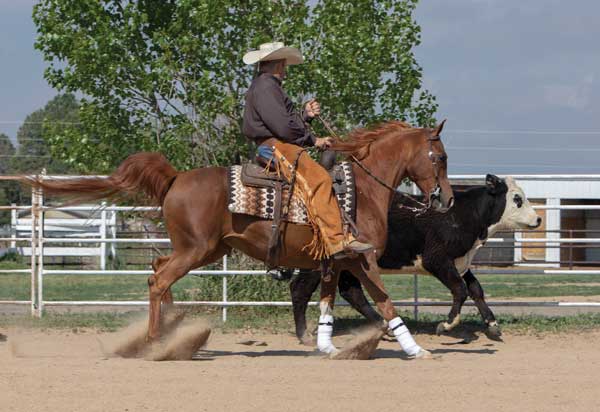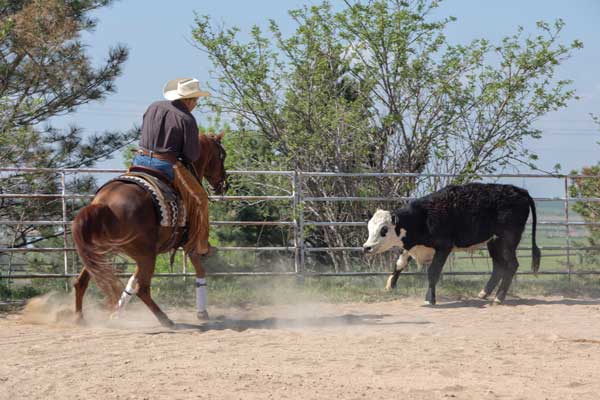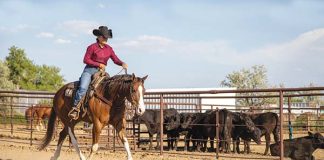
Try it once. Cattle work can be addictive. Once you’ve learned how to quietly ride into a herd and you trust your horse to listen to your commands, as introduced in “Introducing Your Horse to Cattle” in the August 2019 issue, you can work up to showing in National Reined Cow Horse Association (NRCHA) classes. With many new-to-cattle-work riders interested in learning more, including how to box a cow, the association has focused attention on its “limited” classes.
What Is It?
The rider does not have to work the cow on the long side of the arena, where the cow and horse pick up faster speeds.
“The goal of this class is to introduce the rider to the ‘boxing’ phase of the cow work,” according to the NRCHA rulebook. The horse and rider must keep the cow at the prescribed end of the arena for 50 seconds while they are judged on their control, position, degree of difficulty, eye appeal and time worked.
Trainer Gary Martinez is an NRCHA judge who holds national championships in cutting, reining, working cow horse, ranch pleasure and ranch riding. He coaches riders and trains horses in Fort Lupton, Colo. He prepares riders for the limited classes and is glad that the classes attract more people to the sport. He says the limited classes have gotten quite popular, but the divisions help those who are just learning have a chance to show off their courage and skill.
“The draw of the limited classes is that you don’t have to go down the fence and step in front of the cow,” says Martinez. “That’s a concern for riders who are newer to the sport. You can determine how fast you want to go by how much pressure you put on the cow. If you’re confident and want to put on more pressure, you can work harder. If you want to keep it slower, you can build up to speed when you’re ready.”
Here, Martinez describes all the elements of the limited classes, then provides tips to help you succeed at boxing a cow. Once you understand the big picture of how limited classes work, you’ll want to practice with a pro at home to make sure you’re ready for reined cow work.

Reining Portion
When you enter the ring for a limited class, you’ll first perform a reining pattern. Martinez says that NRCHA reining work isn’t as intense as a National Reining Horse Association pattern.
“It’s slightly abbreviated,” he says. “You don’t do rollbacks. You’ll do circles, a minimum of three stops, and some patterns have either two or three spins.”
For reined cow horse events, judges look for an athletic horse who could easily work a cow.
“We look for some different qualities than in the full reining classes, too,” says Martinez. “We want a horse that stops harder and may not slide as far. We don’t want the horse to slide by the cow, but to stop hard when needed. We’re looking for a physical performer.”
Once the reining pattern is finished, you’ll walk to the far end of the arena, and the event staff will let the cow in.
“Once the cow is in the arena, you have 50 seconds to work,”says Martinez. “We want to see you and your horse stepping up and taking control.”
Time to Box a Cow
When it’s time for cattle work when you box a cow, you’ll keep the cow from moving to the other end of the arena—and also show off your skills as you control the cow’s movements.
“You want to mirror how the cow is moving,” says Martinez
If you’re new to the sport, don’t approach the cow too closely. The cow will move more slowly without tight pressure. You may also allow the cow to move from one side of the arena to the other; track the cow but don’t turn too frequently.
When you’re ready to advance, keep your cow about 20 feet from each side of the arena. Move closer to the cow and keep him close to the middle of the pen, turning him frequently to stay in the middle.
“If you step up and keep the cow in the middle of the arena, I know that you’re in control,” says Martinez. “That will up the degree of difficulty. We’re also looking for a horse that does this with finesse and style. We don’t want to see you have to kick hard to keep up with the cow. Eye appeal is among the criteria. If you have to rein your horse around harshly, that’s not as pleasing to watch.”

Martinez describes a perfect limited class boxing session.
“When the cow comes out, you want to be straight out from the gate and 40 to 60 feet away,” he says. “As he enters, approach at an angle so that you can control him. When the gate closes, you’ll step closer to the cow. If you need more action, you’ll step closer. You may have the best cow horse in the world, but he should not go to work without your command. You should dictate where to move and how fast you want to go.”
When you want to turn the cow back toward the center, ride so that your horse’s eye is slightly in front of the cow. “Every cow has a different ‘bubble,’” says Martinez. “Find how much you need to be in front of him to cause him to turn. Then make sure to guide your horse through the turn. If you think about slow turns, you’ll actually speed up because you’ll ride correctly and get out of your horse’s way. It’s a mental thing that seems to work.”
Position is key as you box a cow. Martinez says that it’s fine to hold on to the saddle horn, but make sure to push down on it and not pull back. This will help you keep your balance.
“Let your back [soften] so that you’re a little slumped in the saddle,” he says. “Relax enough to get your weight onto your seat bones. You’ll need to be aware of where the cow is moving and mirror him until the horn blows.”
What if the cow gets away?
“Go get him and go back to work,” says Martinez. “You’ll get penalties for loss of control and for working out of position, but you can keep riding.”
Score Card for Boxing a Cow
You’ll ride better when you understand how you’re being judged. When you walk into the arena, you have 70 points. Then you can gain or lose points based on your performance.
Martinez says that judges look for position and control. The judge wants to see that you and your horse are in the best position to stop and turn the cow. You get more points for staying even with the cow so that it can’t get to the end of the arena before you do.
Your degree of difficulty points go up if you get a cow that requires some work to move and to turn. If the cow you draw runs back and forth on his own, you won’t earn points for degree of difficulty.
The judges want to see a horse that looks interested in the task. Martinez says that you’re allowed to rein and cue your horse, but doing less will lead to more eye appeal. A horse that moves well will also score well.
If you have a tough cow and back off instead of working the cow, that shows a lack of courage. Increase your points by adopting this thought as soon as you enter the pen: “Look at my horse—I’ll show you how good he is by showing you more action from a tough cow.”
Make sure that your horse doesn’t stand still but actually tracks and turns the cow. Your score for “time worked” will improve when you keep moving. If you’re at a standstill for more than a second, you’ll lose points.
Consider watching several NRCHA shows before you and your horse choose to participate to understand what’s required. Watching riders with experience will also boost your own confidence. Once you watch, you’ll want to get home and practice so that you can do it yourself.
Special thanks to Gary Martinez for assistance with photos. Martinez is riding Antonina SF, a purebred Arabian multi-national champion in reining and reined cowhorse. She is owned by Jacobucci Arabians of Brighton.
This article on how to box a cow originally appeared in the December 2019 issue of Horse Illustrated magazine. Click here to subscribe!






